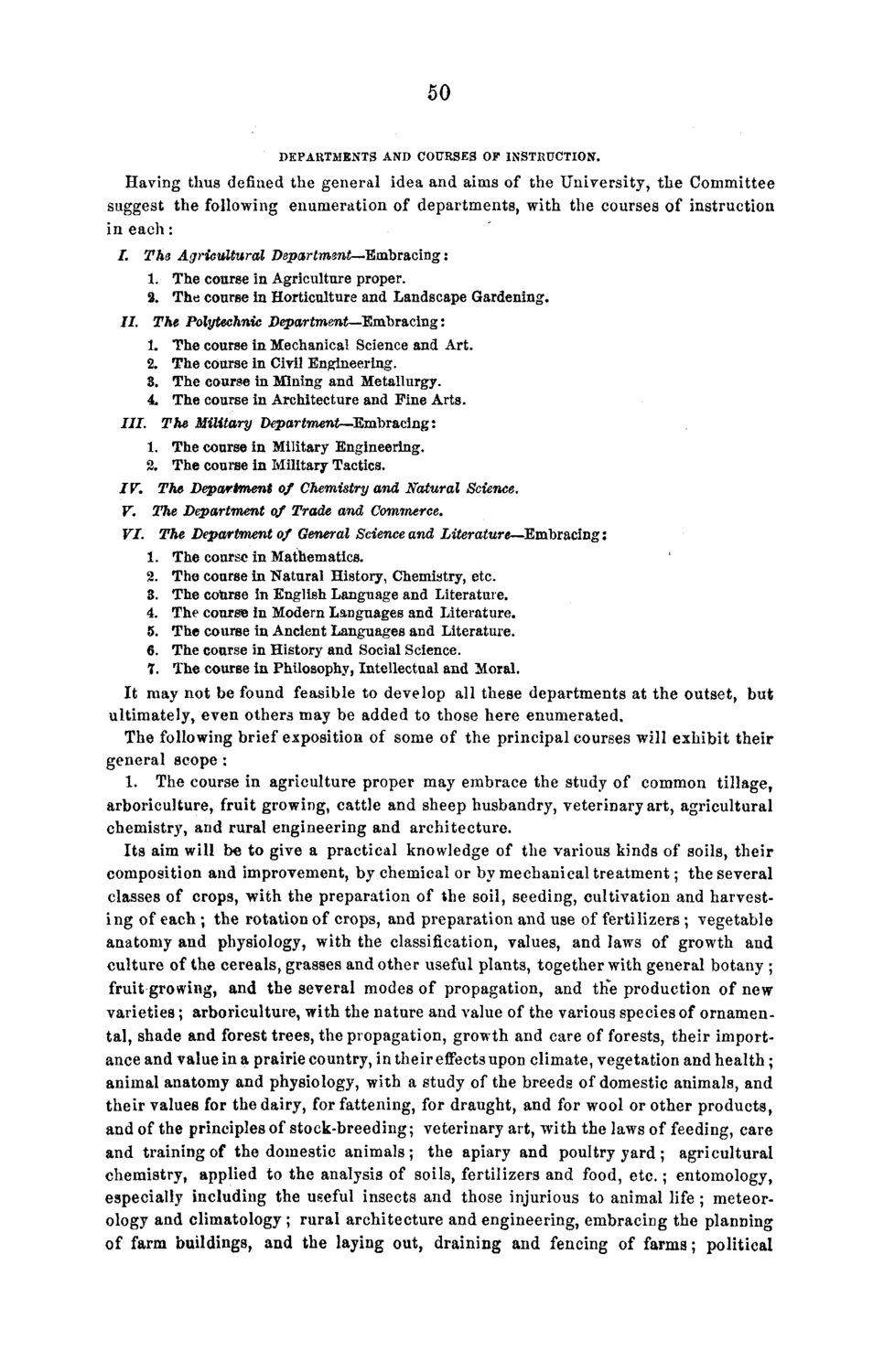| |
| |
Caption: Board of Trustees Minutes - 1868
This is a reduced-resolution page image for fast online browsing.

EXTRACTED TEXT FROM PAGE:
50 DEPARTMENTS AND COURSES OP INSTRUCTION. Having thus defined the g e n e r a l idea and aims of the U n i v e r s i t y , t h e Committee suggest t h e following enumeration of d e p a r t m e n t s , with the courses of instruction in e a c h : / . The Agi'icuttural Department—Embracing: 1. The course in Agriculture proper. 2. The course in Horticulture and Landscape Gardening. //. The Polytechnic 1. 2. 3. 4. Department—Embracing: The course in Mechanical Science and Art. The course in Civil Engineering. The course in Mining and Metallurgy. The course in Architecture and Fine Arts. III. The Military Department—Embracing: 1. The course in Military Engineering. 2. The course in Military Tactics. IV. The Department of Chemistry and Natural Science. V. The Department of Trade and Cominerce. VI. The Department of General Science and Literature—Embracing: 1. The course in Mathematics. 2. The course in Natural History, Chemistry, etc. 3. The course in English Language and Literature. 4. The course in Modern Languages and Literature. 5. The course in Ancient Languages and Literature. 6. The course in History and Social Science. 7. The course in Philosophy, Intellectual and Moral. I t may n o t be found feasible to develop all these d e p a r t m e n t s at t h e outset, b u t ultimately, e v e n o t h e r s may be a d d e d t o those h e r e e n u m e r a t e d . The following b r i e f exposition of some of t h e p r i n c i p a l courses will e x h i b i t t h e i r g e n e r a l scope : 1. The course in agriculture proper may embrace the study of common tillage, arboriculture, fruit growing, cattle and sheep husbandry, veterinary art, agricultural chemistry, and rural e n g i n e e r i n g and a r c h i t e c t u r e . I t s aim will be to give a p r a c t i c a l knowledge of t h e various kinds of soils, t h e i r composition and improvement, by chemical or by m e c h a n i c a l t r e a t m e n t ; t h e several classes of crops, w i t h the p r e p a r a t i o n of the soil, seeding, cultivation and harvesti n g of each ; t h e rotation of crops, and p r e p a r a t i o n and use of fertilizers ; vegetable anatomy and physiology, w i t h the classification, values, and laws of growth and c u l t u r e of t h e c e r e a l s , grasses and o t h e r useful plants, t o g e t h e r with g e n e r a l botany ; fruit growing, and t h e several modes of propagation, and th*e p r o d u c t i o n of new v a r i e t i e s ; arboriculture, with t h e nature and value of the various species of o r n a m e n t a l , shade and forest trees, the p r o p a g a t i o n , growth and care of forests, t h e i r importance and value in a prairie country, in t h e i r effects upon climate, vegetation and h e a l t h ; animal anatomy and physiology, with a study of the breeds of domestic animals, and t h e i r values for the dairy, for fattening, for d r a u g h t , and for wool or o t h e r p r o d u c t s , and of the principles of s t o c k - b r e e d i n g ; veterinary art, w i t h the laws of feeding, care and training of the domestic a n i m a l s ; t h e apiary and poultry y a r d ; a g r i c u l t u r a l chemistry, applied to t h e analysis of soils, fertilizers and food, e t c . ; entomology, especially including the useful insects and those injurious to animal life ; meteorology and climatology ; r u r a l a r c h i t e c t u r e and engineering, e m b r a c i n g t h e planning of farm buildings, and the laying out, d r a i n i n g and fencing of f a r m s ; political
| |